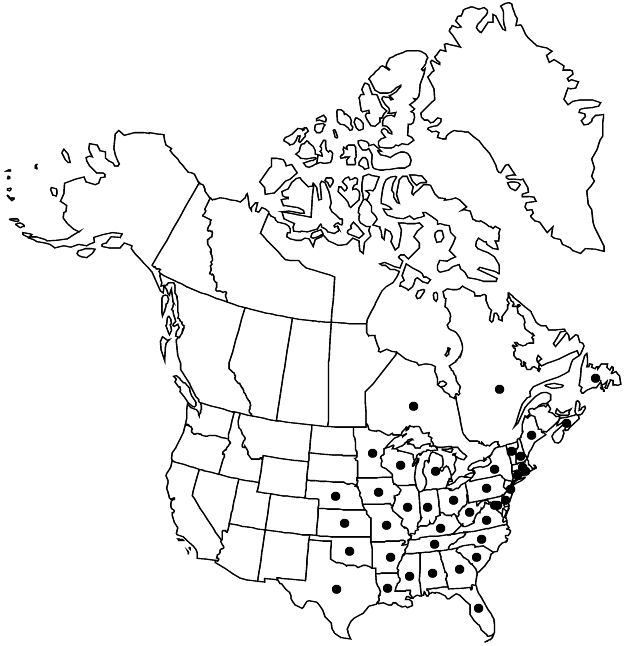Difference between revisions of "Hypericum punctatum"
in J. Lamarck et al., Encycl. 4: 164. 1797.
FNA>Volume Importer |
FNA>Volume Importer |
(No difference)
| |
Revision as of 20:14, 24 September 2019
Herbs erect to ascending, with rarely rooting, branching base, 1.3–10.5 dm. Stems clustered, internodes not lined, with black glands scattered all over. Leaves spreading or ascending, usually sessile, rarely petiolate (to 1 mm); blade elliptic or oblong to lanceolate or triangular-lanceolate, or oblanceolate, 14–40(–58) × 3–17(–22.5) mm, base cordate to narrowly cuneate, margins plane, apex usually rounded to retuse, rarely acute to obtuse, midrib with 3–5 pairs of branches, tertiary veins densely reticulate toward margins, black glands intramarginal (dense) and laminar (scattered). Inflorescences subcorymbiform to cylindric, 10–206(–600)-flowered, subsidiary branches narrowly ascending to curved-ascending. Flowers 8–15 mm diam.; sepals not imbricate, erect in fruit, lanceolate or oblong-lanceolate to elliptic or ovate-elliptic, subequal, (1.5–)2–4 × 0.8–1.6 mm, apex acute to rounded; petals pale yellow, oblanceolate to elliptic, 3–6(–9) mm; stamens (20–)30–60; anther gland black; styles 1–4 mm. Capsules ovoid to subglobose, 2.5–6 × 2–3.5(–4) mm, with longitudinal vittae or elongate to ovoid vesicles. Seeds not carinate, 0.5–0.7 mm; testa linear-reticulate. 2n = 14, 16.
Phenology: Flowering summer (May–Sep).
Habitat: Open or slightly shaded, dry to marshy habitats
Elevation: 50–1200 m
Distribution

Nfld. and Labr. (Nfld.), N.S., Ont., Que., Ala., Ark., Conn., Del., D.C., Fla., Ga., Ill., Ind., Iowa, Kans., Ky., La., Maine, Md., Mass., Mich., Minn., Miss., Mo., Nebr., N.H., N.J., N.Y., N.C., Ohio, Okla., Pa., R.I., S.C., Tenn., Tex., Vt., Va., W.Va., Wis.
Discussion
Hypericum punctatum has been confused with H. pseudomaculatum; it can almost always be distinguished by style length and anther gland (black in H. punctatum, amber or pellucid in H. pseudomaculatum). D. E. Culwell’s (1970) record of one specimen of the latter from Missouri with a black anther gland could refer to a hybrid; he and other authors agree that such plants are rare, despite the considerable overlap in distribution of these species. Culwell remarked on the unexpected fecundity of the experimentally produced cross H. graveolens × punctatum but nowhere compared the resulting plants with H. ×mitchellianum, a probable hybrid with that parentage (see discussion
under H. ×mitchellianum. Both H. punctatum and H. ×mitchellianum (but not H. graveolens) display a ring of 16 chromosomes at meiosis, and Culwell suggested that this phenomenon may imply some degree of pseudogamy in the group. C. R. Bell (1965) recorded n = 7 chromosomes for this species; his illustration shows n = 8.
Selected References
None.